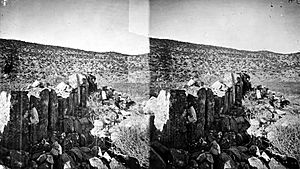San Juan County, Utah facts for kids
Quick facts for kids
San Juan County
|
|
|---|---|
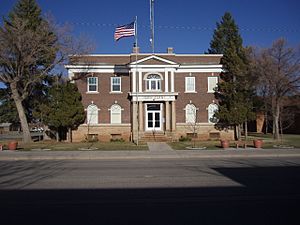
San Juan County Courthouse, Monticello
|
|
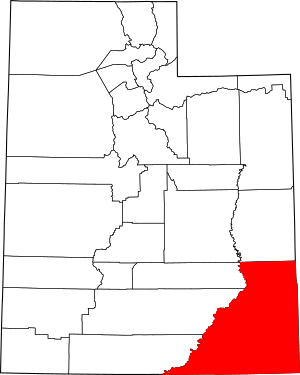
Location within the U.S. state of Utah
|
|
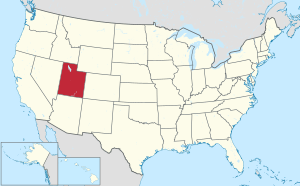 Utah's location within the U.S. |
|
| Country | |
| State | |
| Founded | February 17, 1880 |
| Named for | San Juan River |
| Seat | Monticello |
| Largest city | Blanding |
| Area | |
| • Total | 7,933 sq mi (20,550 km2) |
| • Land | 7,820 sq mi (20,300 km2) |
| • Water | 113 sq mi (290 km2) 1.4% |
| Population
(2020)
|
|
| • Total | 14,518 |
| • Estimate
(2023)
|
14,358 |
| • Density | 1.83008/sq mi (0.70660/km2) |
| Time zone | UTC−7 (Mountain) |
| • Summer (DST) | UTC−6 (MDT) |
| Congressional district | 3rd |
San Juan County is a county located in the southeastern part of Utah, a state in the United States. As of 2020, about 14,518 people live here. The main town and county seat is Monticello, but the biggest city is Blanding. The county was named after the San Juan River. Spanish explorers gave the river its name, honoring Saint John.
San Juan County is special because it meets the borders of three other states: Arizona, Colorado, and New Mexico. This meeting point is known as the Four Corners.
Contents
History
The area that is now San Juan County was officially created on February 17, 1880. It was formed from parts of other counties in Utah. Since then, its borders have not changed. The town of Monticello was started in 1887. By 1895, it had grown enough to become the official county seat of San Juan County.
Geography
San Juan County is in the very southeast corner of Utah. It touches the borders of Colorado, New Mexico, and Arizona. The famous Four Corners Monument, where these four states meet, is right in the county's southeastern tip.
The land in the county generally slopes down towards the west and south. The highest point is Mount Peale, which is about 12,726 feet (3,879 meters) above sea level. The county covers a huge area of about 7,933 square miles (20,546 square kilometers). Most of this is land, with a small part being water. It is the largest county in Utah by size.
The western and southern edges of the county have deep canyons. These were carved by the Colorado River and the San Juan River. Many smaller canyons cut through the desert rock layers, creating cliffs and flat-topped hills called plateaus. In the middle of the county, you can find places like Cedar Mesa, Comb Wash, Natural Bridges National Monument, and Hovenweep National Monument. A large part of Canyonlands National Park is also within the county. The eastern side of Glen Canyon National Recreation Area and Lake Powell are here too.
The Blue (Abajo) Mountains and the La Sal Mountains are very tall, reaching over 12,000 feet (3,658 meters). These mountains are covered with green forests, which look very different from the deserts below. The elevation in the county changes a lot, from almost 13,000 feet (3,962 meters) in the La Sal Mountains to about 3,000 feet (914 meters) at Lake Powell. That's a difference of about 10,000 feet (3,048 meters)!
The towns in San Juan County are mostly found along two main roads, U.S. Route 191 and U.S. Route 163. These roads run from La Sal in the north down to Monument Valley in the south.
Natural resources
San Juan County has some important natural resources. In 2018, the only plant in the United States that processed uranium was located in Blanding. However, it was put on standby in 2019.
The county also has many oil and gas fields. These fields produce oil and gas from deep underground rock layers.
Major highways
 US-163
US-163 US-191
US-191 US-491
US-491- SR-46
- SR-95
- SR-162
- SR-261
- SR-276
Adjacent counties

- Grand County - north
- Mesa County, Colorado - northeast
- Montrose County, Colorado - northeast
- San Miguel County, Colorado - east
- Dolores County, Colorado - east
- Montezuma County, Colorado - east
- San Juan County, New Mexico - southeast
- Apache County, Arizona - south
- Navajo County, Arizona - south
- Coconino County, Arizona - southwest
- Kane County - west
- Garfield County - west
- Wayne County - west
- Emery County - northwest
San Juan County shares borders with more other counties than any other county in the United States. It borders 14 different counties!
Protected areas
- Bears Ears National Monument
- Canyonlands National Park (part)
- Dark Canyon Wilderness
- Edge of the Cedars State Park
- Four Corners Monument Navajo Tribal Park (part)
- Glen Canyon National Recreation Area (part)
- Grand Gulch Primitive Area
- Goosenecks State Park
- Hovenweep National Monument (part)
- Manti-La Sal National Forest (part)
- Monument Valley Navajo Tribal Park (part)
- Natural Bridges National Monument
- Navajo Mountain
- Rainbow Bridge National Monument
- Valley of the Gods
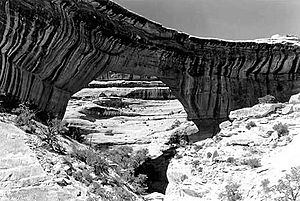
Demographics
San Juan County's population has grown over the years. In 1880, there were only 204 people. By 2020, the population had grown to 14,518. In 2017, San Juan County had one of the lower average incomes per person in Utah.
2020 census
According to the 2020 United States census, there were 14,518 people living in San Juan County. This means there were about 1.9 people per square mile.
Here's a look at the different groups of people living in San Juan County:
- About 49.5% were Native American.
- About 41.6% were White (not Hispanic or Latino).
- About 5.1% were Hispanic or Latino.
- Smaller numbers of people were Black, Asian, Pacific Islander, or from two or more races.
The population was almost evenly split between males and females. About 28.8% of the people were under 18 years old. The average age was 34.6 years.
There were about 4,649 households in the county. Most of these (about 73%) were families. The average household had about 3 people. Most homes (about 79.8%) were owned by the people living in them.
The average income for a household in San Juan County was about $49,690 per year. For families, it was about $57,401. About 22.8% of the people and 18.1% of families lived below the poverty line.
When it comes to education, about 30.5% of adults (25 or older) had a high school diploma. About 36.1% had some college education or an associate degree. A smaller number had a bachelor's degree or a higher degree.
Communities
Cities
- Blanding
- Monticello (county seat)
Town
Census-designated places
Unincorporated communities
- Eastland
- Ucolo
See also
 In Spanish: Condado de San Juan (Utah) para niños
In Spanish: Condado de San Juan (Utah) para niños


